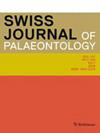Bernhard Peyer 和他在瑞士发现的三叠纪脊椎动物
IF 3
2区 地球科学
Q1 PALEONTOLOGY
引用次数: 0
摘要
Bernhard Peyer(1885-1963 年)是瑞士著名的古脊椎动物学家和苏黎世大学解剖学家。1919 年,他在瑞士和意大利交界处的圣乔治山发现了三叠纪中期(阿尼斯期-拉迪尼期)的鱼龙、长鼻龙和其他爬行动物。从 1924 年开始,佩耶和他后来的学生和继任者埃米尔-库恩-施奈德(Emil Kuhn-Schnyder)孜孜不倦地在这一地区的化石矿床中挖掘和收集材料。1929 年,佩耶发现了一具长颈爬行动物的关节骨架,从而解开了德国 Muschelkalk 地区异常细长骨骼的谜团,他证明这些骨骼是超长颈爬行动物 Tanystropheus 的颈椎骨。1919 年和 1942 年,作为一名学生,佩耶在他的家乡沙夫豪森附近勘探了一个雷提亚骨床。在处理沉积物时,他发现了许多脊椎动物的小骨头和牙齿,其中各种茎哺乳动物的牙齿尤为重要。本文章由计算机程序翻译,如有差异,请以英文原文为准。
Bernhard Peyer and his discoveries of Triassic vertebrates in Switzerland
Bernhard Peyer (1885–1963) was a prominent Swiss vertebrate palaeontologist and anatomist at the University of Zurich. In 1919, he discovered the occurrence of Middle Triassic (Anisian–Ladinian) ichthyosaurs, sauropterygians, and other reptiles at Monte San Giorgio on the border between Switzerland and Italy. Starting in 1924, Peyer, and later his student and successor Emil Kuhn-Schnyder, worked tirelessly to excavate and collect material from fossil-bearing deposits in this region. The discovery of an articulated skeleton of a long-necked reptile in 1929 allowed Peyer to solve the riddle of unusually elongate bones from the German Muschelkalk, which, he demonstrated, were cervical vertebrae of the extraordinarily long-necked reptile Tanystropheus. As a student in 1919 and later in 1942, Peyer explored a Rhaetian bonebed close to his native town of Schaffhausen. Processing the sediment, he recovered numerous small bones and teeth of vertebrates, among which teeth of diverse stem-mammals are of particular importance.
求助全文
通过发布文献求助,成功后即可免费获取论文全文。
去求助
来源期刊

Swiss Journal of Palaeontology
Earth and Planetary Sciences-Paleontology
CiteScore
4.30
自引率
16.70%
发文量
17
审稿时长
4 weeks
期刊介绍:
The Swiss Journal of Palaeontology publishes original research and review articles of interest to the international community in the fields of palaeontology, taxonomy and systematics, while recognising at the same time the importance of documenting high-quality palaeontological data in a regional context. Palaeobiology in combination with alpha taxonomy is a core topic of the journal.
Submitted papers should have an appeal as wide as possible, directed towards an international readership. Contributions should not have been simultaneously submitted elsewhere, and the overlap of content between related articles should be minimal. Duplications of text and the use of previously published illustrations without adequate citation are unacceptable. If a manuscript has two or more authors, both or all have to sign to confirm they all were involved in the work and have agreed to its submission. The preferred manuscript language is UK English, but consistently used US English is also acceptable. We encourage the publication of proceedings of international meetings as well as special thematic issues. Short contributions and book reviews are also accepted.
An international editorial team as well as guest editors guarantee that the thematic issues as well as all articles in regular issues are peer-reviewed and meet the highest standards.
 求助内容:
求助内容: 应助结果提醒方式:
应助结果提醒方式:


